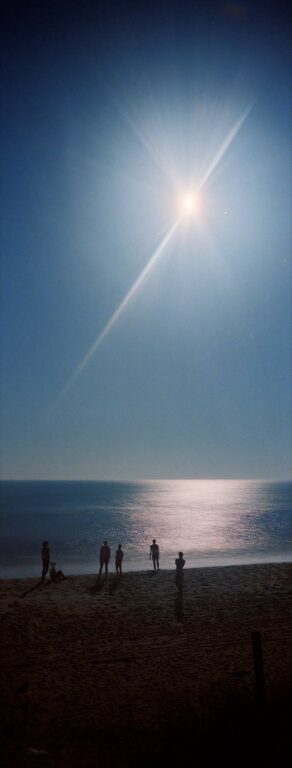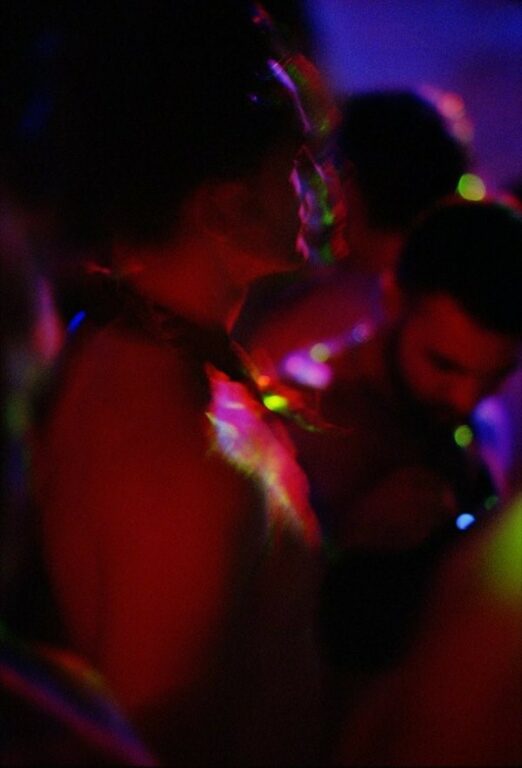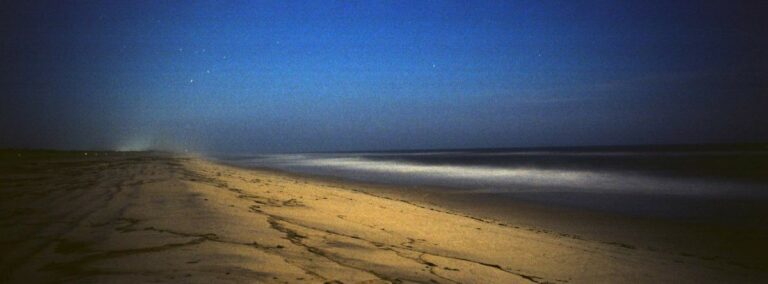Visualise a place just a few hours from the city, where the beaches are sandy, the parties unbridled and the sunsets and the people are equally beautiful. Some version of this scene exists for many of us as something both real and imagined; dreamt up amid everyday drudgery, or bought and sold as a package deal. ‘The beach is always there’, writes Zadie Smith, in an essay on ambition and shoreline fantasies, ‘you just have to conceive of it.’ New York’s Fire Island is, on the surface, one such place, a mythic site of great natural beauty, where no cars are allowed, and all just a train and a ferry ride away from Manhattan.

Matthew Leifheit, Frank O’Hara Death Site
This long, thin spit of land off the South Shore of Long Island has been home to numerous vacation communities, some of which date as far back as the late nineteenth century. In the early years of the island’s development, when the vacation was becoming a more regular fixture of summer life in the US, Fire Island offered a rustic, rather than luxurious, outpost. There was a large hotel at one end of the island, and a casino at the other, but much of the accommodation for vacationing families consisted of beach shacks with very few amenities. Today there are approximately seventeen communities, their populations made up of homeowners, renters and day trippers who come out to the island during the May–October season, with a smaller number of year-round residents. But two of these communities in particular, Cherry Grove and Fire Island Pines, have come to inform the island’s reputation more broadly as a destination associated with deviancy. Uttered outside of the metropolitan or Long Island area, beyond the immediate milieu of the New Yorkers who go there each summer, the words ‘Fire Island’ are readily synonymous, for many, with a certain vision of queer utopia; a place of safety and sexual freedom, where you can hold your partner’s hand without judgment, and join an orgy in the wooded area known as the Meat Rack, if you’re so inclined. But as is the case with most utopian constructions, the truth is a little more complicated.
Both Cherry Grove and the Pines began as spots for families. The Grove, which dates back to the 1880s, was envisaged by its early homeowners as a place where a wholesome, traditional and altogether heteronormative way of life might take root. This didn’t last for long. A hurricane in Cherry Grove in 1938 swept away many of the properties, meaning empty lots were sold off cheaply to people from the city (known euphemistically, Esther Newton notes in her groundbreaking history of the community, as the ‘theatre people’). When it was developed in the 1950s, upon the vacant land that had, for some time, been inhabited by a nudist colony, Fire Island Pines was intended to offer a more discreet getaway for gays and lesbians migrating from Cherry Grove, whose outré drag culture and well-known opportunities for public sex were beginning to make it infamous. However, the imposing sign erected in the Pines – which delineated it as ‘A Family Community’ – was no match for the post-liberation era of the 1970s, a cultural and sexual boom catalysed by the Stonewall riots; a decade of drugs and disco that brought legendary gay parties to the island’s shores.

Matthew Leifheit, Underwear Party
Hedonism has long been a part of Fire Island’s illustrious history. Writers including W.H. Auden, Carson McCullers and Patricia Highsmith went drinking in Cherry Grove’s bars in the post-war, pre-Stonewall years, while some of the best-known gay novelists of the 1970s, wrote about the island’s sexual culture, its cruising spaces and obsessions with the body. That the party culture persisted throughout the worst years of the HIV/AIDS epidemic in the 1980s and 90s speaks to the importance of pleasure and its various expressions on Fire Island. It still thrives today during the summer season, with the daily ‘tea dance’ – an afternoon drinks and dance party and crucial fixture in the social schedule – as well as the Friday night underwear party and annual beach events. This dual capacity to be yourself and to let your hair down is celebrated throughout the history of the island, while its contemporary reputation as a place to get undressed or be messy feels like a riposte to political agendas which suggest that gays and lesbians now can, and should, socially conform.
In a scene from Fire Island, a new gay romcom written by comedian Joel Kim Booster and now streaming on Disney+, the film’s central group of friends congregate for the tea dance on the deck of The Blue Whale, one of the storied bars located at the harbour of the Pines. Across the deck, toned and shirtless men are dancing, drinking and shooting loaded glances at each other, while a thumping remix of Charli XCX’s song ‘Boys’ plays in the background. ‘I can’t imagine that this is what the Gay Liberation Front envisioned for us,’ says Max (Torian Miller) to the group. ‘Other than the Charli XCX remix,’ replies Noah (Kim Booster), ‘I think this is exactly what they envisioned for us.’ Within this passing gag is an important question about what it might mean to think of Fire Island as a radical space.
This ‘Pleasure Island’ – as W.H. Auden dubbed it in his 1948 poem about Cherry Grove – might seem at first glance like the utopia imagined by activists during the radical, sex-positive fervour of the 1970s. Back in the 1960s, for example, the Mattachine Society (an early gay rights group) went to the island to hand out flyers to raise awareness about legal and civil rights, following a series of police raids targeting gay men who went nude on the beach and cruised in the wooded area known as the Meat Rack. But the activists were not received with open arms; as Newton notes, there was an ‘anti-political’ spirit among the older generation of residents, who were more accustomed to using the island as an enclave in which to hide, rather than fight publicly for recognition. The flourishing of a visible queer culture in the liberationist 1970s made Fire Island an iconic destination, a physical realisation of sexual freedoms that had long been repressed. But if this heyday of glamour and hedonism in the disco era was itself political, a new freedom that had been hard-won, the island’s relationship to political action remained complex.
In his sunny 1976 travelogue Welcome to Fire Island, the activist and journalist Jack Nichols saw Fire Island as providing a blueprint for a more radical and communitarian place, a ‘prototype of what America might yet become: a neighbourly community.’ To achieve this, Nichols argued, the island communities would need to evade the municipal clasp of the Long Island towns that governed them and charged high taxes; secession from the mainland would help return these places to their original, ungoverned state, from which a new co-operative could be rebuilt, of the kind often espoused in anarchist circles.
That this never came to pass was little surprise to the writers who, in the same era, observed a certain apolitical bent among the island’s revellers. While many of the city’s gay community walked in the gay liberation march through Central Park, the characters from Andrew Holleran’s classic 1978 novel Dancer from the Dance ‘were all at the beach, darling; they couldn’t be bothered to come in and make a political statement.’ For those that could be bothered with politics, being on Fire Island was often a case of being off duty. The narrator of George Whitmore’s 1980 novel The Confessions of Danny Slocum, for example, encounters one of his more politically active friends on the dance floor of The Sandpiper, a popular bar of the period in the Pines. Instead of his usual activist attire (leathers and jeans), this man is now dressed in a lurid, preppy outfit (lemon trousers, pink shirt, blue shoes), ‘consorting so enthusiastically with the very milieu he’s always seemed to resent so – as exemplifying all the ills of gay life: ingrown, artificial, hedonistic, uncharitable, moneyed.’ Critiques of the culture’s insularity could also be controversial, as Larry Kramer found out when the 1978 publication of his novel Faggots, a satire of gay life in New York, made him an unpopular guest in the Pines.

Matthew Leifheit, Margaret Fuller Death Site
As I learned in writing a book about the queer literary history of Fire Island, it is difficult to speak of the place in general terms. Cherry Grove, with its fairy lights, drag shows and small cottages, has a markedly different feel from the sleek, maximalist aesthetic of the Pines. Survey any weekend crowd in either community and you’d be likely to find people looking for altogether different experiences. Some are there for the parties, others for the art. A stretch of the beach might show a shirtless volleyball match, and a couple passing by for a quiet walk by the ocean. Artist residency programmes like FIAR and BOFFO have revived and diversified the island’s creative culture. In a New York Times piece on the latter, the painter Nicole Eisenman notes that ‘There’s the Pines everybody thinks of – the mainstream party culture – and then there’s this other parallel world of art queerdos.’ Different populations co-exist, as do different generations. And while both communities have been predominantly white and middle class, contemporary community initiatives like BaBEC (the Black and Brown Equity Coalition of Fire Island) are working to address the structural barriers that prevent a more diverse array of people accessing this summer enclave.
If the value and the purpose of Fire Island to the wider queer community have been hard to agree on, historically speaking, its continued significance in queer culture over the last century, as well as its resilience in the face of hurricanes, police raids and the devastation of the HIV/AIDS epidemic, speaks to the importance of paradise as a site of fantasy, both as an abstract idea and a real place that can be found, just off the shores of Long Island. Andrew Holleran notes, in one of his essays about HIV/AIDS from the 1980s, a phrase that a friend kept returning to amid the relentless crises of that era: ‘There must be a beach at the end of this.’ The climactic scene of the 1989 film Longtime Companion, about the early years of the epidemic in New York, visually enacts such a maxim in the way it imagines a utopian afterlife in which all those who died might come back together again, congregating joyfully on the picturesque sands at the edge of the Atlantic.
The beach is always there, after all, an evolving landscape that feels oddly timeless, the shifting foundations of a complex land that is as ‘slim as a parenthesis’ (as Holleran puts it in Dancer from the Dance). This motif, of the island’s simultaneous vitality and deathliness, is captured hauntingly in photographer Matthew Leifheit’s images of the shore in his recent collection To Die Alive. In one deserted scene, Leifheit illuminates the death site of Margaret Fuller, the nineteenth-century journalist and feminist thinker, whose ship crashed off the coast of Fire Island in 1855. In another, a more populated image, capturing the glare of the sun, the viewer looks on at the death site of Frank O’Hara, who was involved in a dune buggy accident on the beach near the Pines in 1966.
Implicit in these images’ play with time, their gestures towards past and present, is the ambiguous, imperilled tense of the island’s own fate, its vulnerability to erosion and the ongoing consequences of climate change. Imagining the place’s disappearance feels simultaneously inevitable and hard to bear, but in either case an apt part of its mythos. Paradises are lost, but archives live to index such sites, places that are both illustrious and ambivalent, and made in the image of better futures.
Image © Matthew Leifheit








